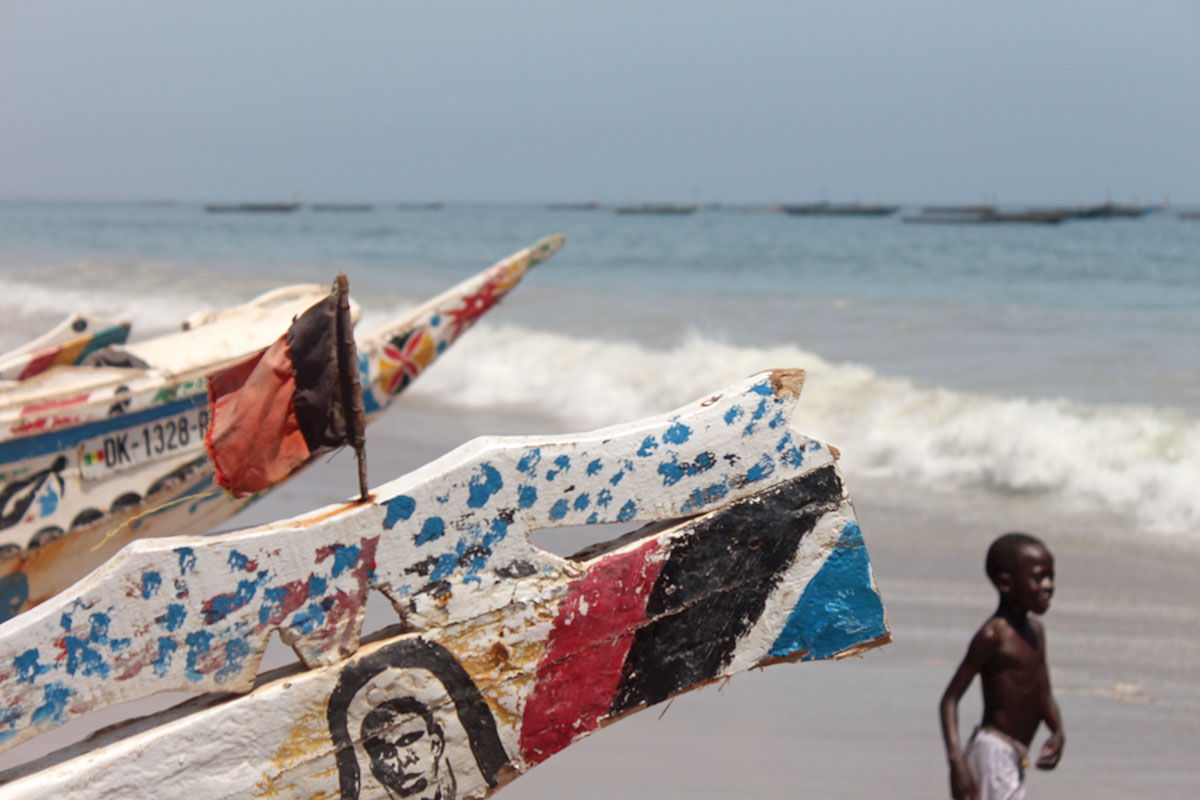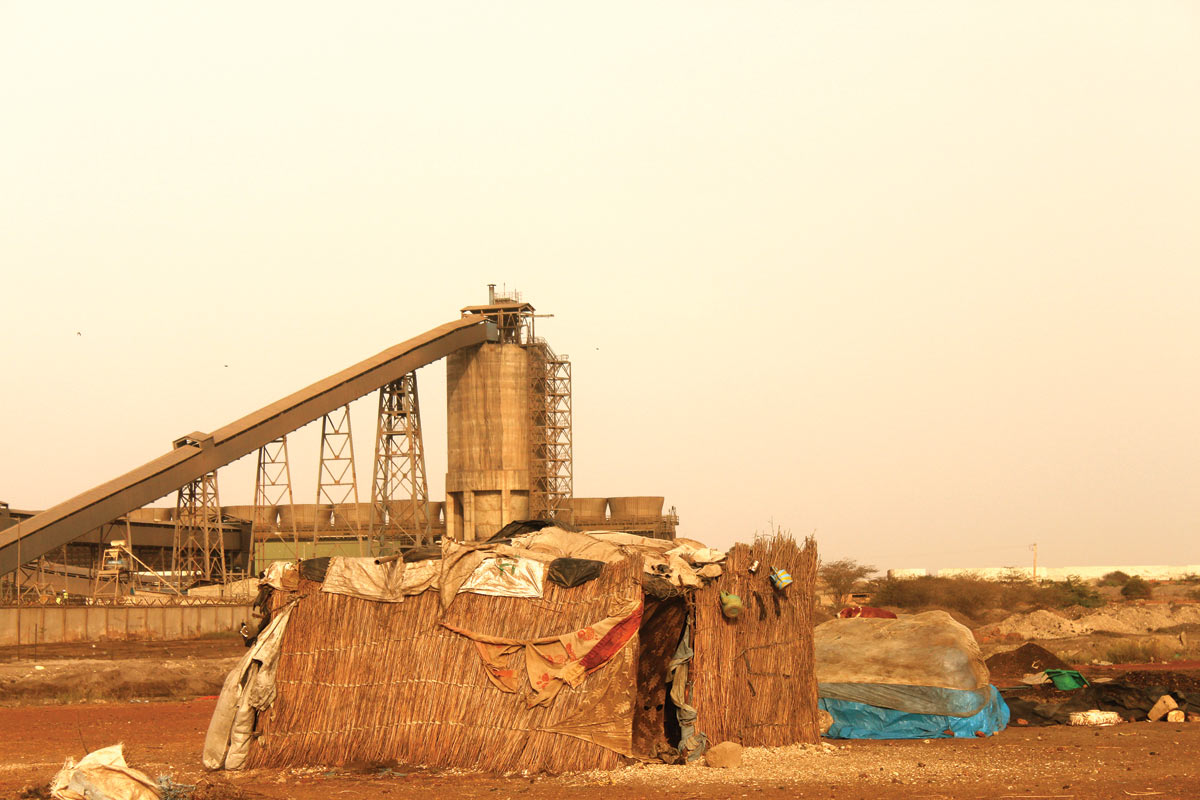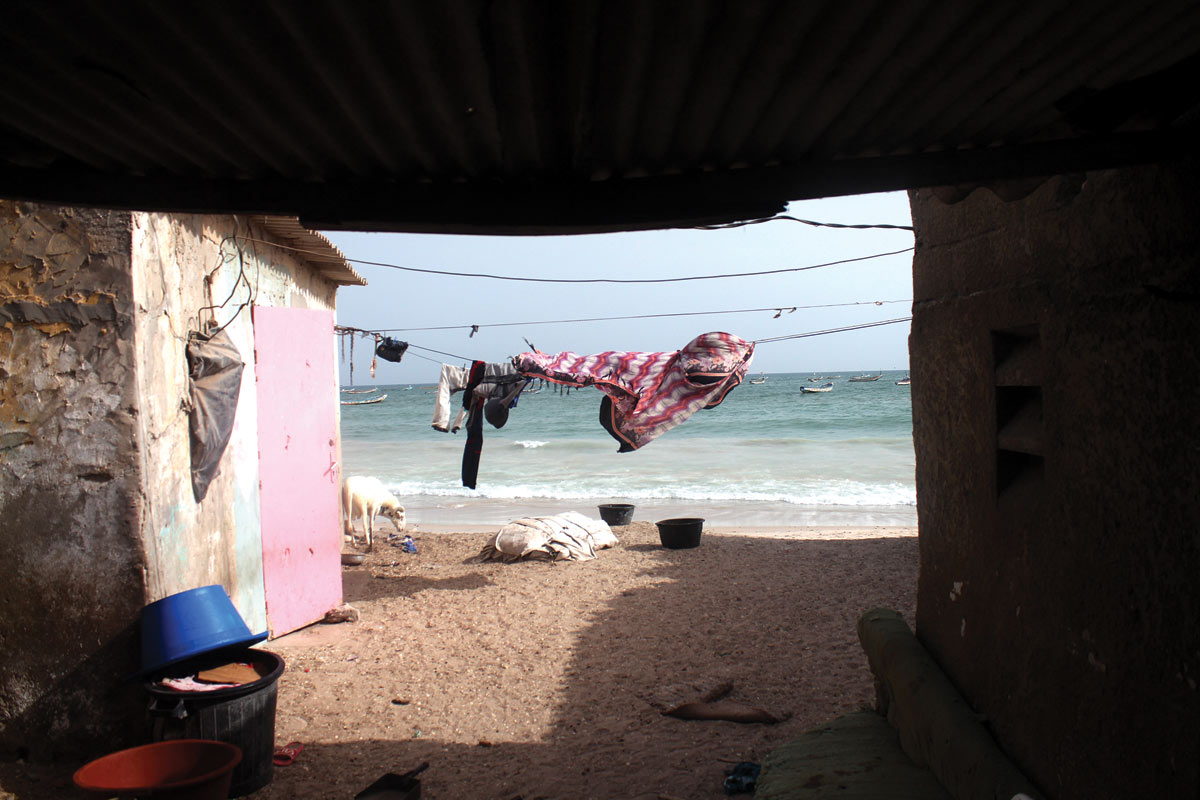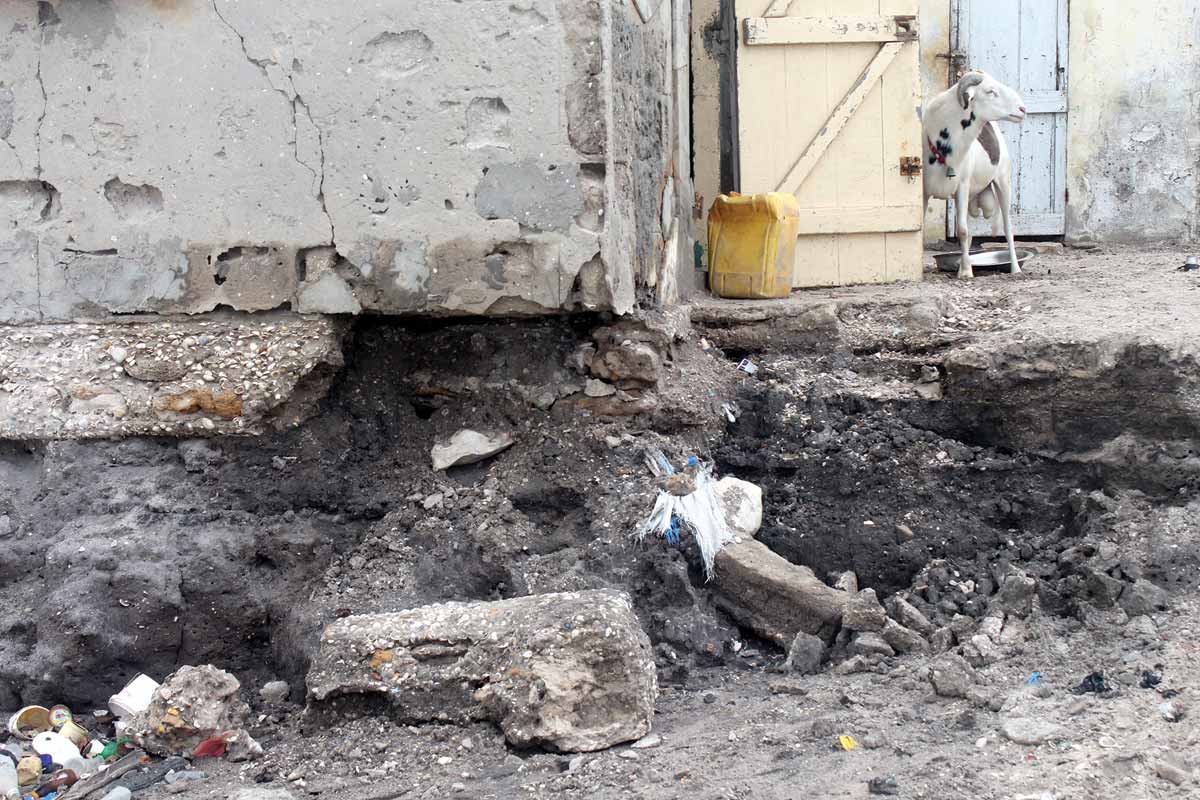“To be honest, I’m worried,” says Daouda Gueye. “The future is almost black. To be an optimist, you have to see what’s next. And right now we can’t see anything. Everything is dark.” He shrugs. “We’re truly cornered.”
We are standing in a field just outside Bargny, a bustling seaside town of 70,000 people some 30 kilometers southeast of Dakar, Senegal’s capital. For decades, Bargny has suffered from severe industrial pollution. The town hosts a hulking cement factory—one of the largest in West Africa—that has flecked Bargny with toxic dust since 1984. Over the past 10 years, two other threats have emerged.
A mere 100 meters east of where Gueye and I stand, a new coal-fired power plant—Senegal’s first, in operation since last fall—waffles in the afternoon heat. Mounds of coal lie at the base of its three chutes, which slope up toward the red-and-gray-striped chimney. The chimney’s thin shadow points, like a stern finger, to the southeast, where rising sea levels and storm surges caused by climate change exact a devastating toll.
Worse, the two threats are linked. The power plant occupies the precise spot that was once designated a site of relocation for those affected by the rising sea. “People lost their homes because of coastal erosion,” Gueye explains. “We are threatened by that. And then when they needed to move, the power plant took that land.”
In a sickening irony, Bargny is trapped between the causes and the effects of climate change. Residents say their town is under siege. “It’s as though we’re being compressed,” Gueye reiterates as we walk past the crumbling seaside houses. “Seriously. There is a future in which Bargny will disappear.”
So far, the town has refused to yield to that future. Gueye is one of the leaders of RAPEN, a local activist organization that was formed when the Senegalese government began construction on the power plant in 2014. For five years, RAPEN has tried to hold off threats from both sides. “Our first goal is to protect us from the sea,” Gueye announced in 2016. “Our second goal is to fight the coal power plant.”
And yet amid Bargny’s resistance—part and parcel of it, perhaps—there is an element of despair, a hopelessness particular to our era of climate crisis. It’s a despair that runs through Gueye’s words. The future is almost black. We’re truly cornered.
Popular
"swipe left below to view more authors"Swipe →
This is the first article in a series about the idea of climate justice—a concept that has only recently come into widespread use. In the landmark 2015 Paris Agreement, the word “justice” appears once, buried in a nonbinding preamble that coyly notes the “importance for some of the concept of ‘climate justice’”—in scare quotes, no less!—“when taking action to address climate change.”
Four years later, a huge rhetorical shift has occurred: The idea of justice is now at the forefront of the climate debate. At the United Nations Climate Change Conference in Poland last December, the official theme was a “just transition” away from a carbon economy—a big change from Paris. (Though that didn’t stop the Polish government from attempting to twist “climate justice” into a defense of coal mines.) At the UN Climate Action Summit in New York this September, we’ll likely hear a fresh chorus of calls for a just transition, a just economy, a just distribution of emissions, and so on. Justice is finally becoming an important term in climate politics. We need to know what it means.
This series tries to define climate justice from the ground up: to ask what justice means for communities already confronting the dual crises of failing climate politics and runaway climate change. Bargny, a small town fighting both of those crises at once, seemed a good place to start.
But the activists and residents I met there steered me to a different question. To understand what climate justice would mean in a place like Bargny, they insisted, we must first take the full measure of the injustice that needs resisting. And they are right: Before we focus on climate justice, we need to grasp the nature of climate injustice.
In Bargny, the outward signs of that injustice—the rising sea, the power plant—are unmistakable. What is less clear but more revealing, once grasped, is how the injustices of climate change and climate politics are changing the way that the residents of Bargny think about life on a fundamental level. We often hear about how climate change creates climate refugees: It forces people to search for a new space in the world. The residents of Bargny are facing a different form of displacement, less visible but no less pernicious. They are becoming homeless without leaving home.
II: Losing the Most
“No region has done less to contribute to the climate crisis,” former UN secretary general Kofi Annan wrote of Africa in 2015, “but no region will pay a higher price for failure to tackle it…. All countries stand to lose” from climate change, he continued, but “Africa will lose the most.”
Senegal, just north of the equator and nestled on the West African coastline, is no exception to Annan’s rule. The country contributes almost nothing to global carbon emissions. Senegal emitted six-tenths of one metric ton of carbon dioxide per capita in 2014, which put it around 150th out of 195 countries. In the same year, the US emitted nearly 17 tons per capita—almost 30 times as much.
And yet Senegal, along with its West African neighbors, stands to suffer some of the worst effects of climate change. Farming communities are already experiencing severe drought. Average temperatures are expected to increase 1 to 3 degrees Celsius by 2060, which would cripple rain-fed agriculture.
The nation’s coastal regions, meanwhile, are reeling from harsher storm surges and unrelenting erosion. In a middle-of-the-road scenario, sea levels along the Senegalese coast could rise a whole meter by 2100. That could destroy much of Senegal’s industrial infrastructure, 90 percent of which hugs the coastline. It could also displace over 100,000 people: Nearly 70 percent of Senegal’s population lives in coastal zones. President Macky Sall has begun to relocate some residents of the hardest-hit areas. In the northern city of Saint-Louis, the World Bank is sponsoring a $30 million effort to support the 10,000 seaside residents who live in high-risk flood areas or have been displaced.
For Fary Ndao, a prominent Senegalese environmentalist, this injustice—contributing to climate change the least, affected by it the most—should be the starting point for any conversation about climate justice in the region. “We have to stress that Senegal and most African countries contribute very little to global warming,” Ndao says. “Senegal is a victim. That is the first thing to say.”
In Bargny, however, many people feel this black-and-white breakdown between contributors and victims doesn’t apply. Senegal may well be a victim on an international level, where most discussions of climate justice tend to take place. But that doesn’t stop it from creating its own victims, too. If Senegal is a victim, Bargny’s residents insist, then Bargny is the victim of a victim—the innermost babushka in the Russian doll of climate injustice. For them, Annan’s words apply one level down: All of Senegal stands to lose, but Bargny will lose the most. One fisherman expresses this with jarring bluntness. “Africa is the trash can of the world!” he yells. “And Bargny is the trash can of Senegal.”
III: What the Sea Ate
“The sea ate.” This is the metaphor of choice in Bargny. Everyone I spoke with, from the fishermen in the port to the women at the market to the activists in their offices, used that phrase to describe what has happened to their coastline and their lives.
Walk along that coastline, and the metaphor immediately makes sense. A sandy beach slopes up to a line of low-slung concrete houses standing precariously on a berm. Storm surges and rain-fed high tides have carved out jagged chunks along the berm’s edge. It does indeed look as if the sea has gnawed at the shore.
The erosion began in the 1980s, Gueye tells me. At first, the cause was poor coastal management farther north, near Dakar. But since the early 2000s, the rate has worsened. Storm surges have become fiercer and more common; Hurricane Fred in 2015 was especially bad. Between the surges and the rise in sea level—which will significantly accelerate in the coming decades, scientists now say—Bargny is currently losing three to four meters of coast each year.
“It’s visible, no?” Gueye says with a touch of perverse pride. It is. We pass multiple homes with their sea-facing walls torn off. You can peer inside the rooms like those in a dollhouse. It rained heavily last night, and Gueye points out the latest damage: The berm beneath a house has crumbled, leaving half of the outermost room dangling over the beach with nothing beneath it. The room is unsafe, the owner tells us. He’ll have to knock it down tomorrow.
More striking still is what is no longer visible. For in the years since Bargny began its fight against the power plant, the sea has already eaten many things.
The sea ate homes. Some it swallowed in their entirety. Abdou Diouf, 56, a fisherman and father of seven, lost his home in 1998. (“The sea ate it,” he says. “It eats, and it eats, and it eats.”) He had no money to move or rebuild. And even if he did, he says, he couldn’t go anywhere; he needs to be by the sea to fish. He moved his family to a friend’s house. They are still there.
Others the sea has merely nibbled to the bone. Diouf tells his story in the living room of Fatou Samba’s home. Fatou Samba is one of the leaders of the femmes transformatrices, the women who smoke, salt, and process fish. The sea began to enter her house last year, slow but persistent, taking one room at a time. “The sea will reach the rest of your house this year,” says Gueye, looking at Fatou Samba across the room. “I’m sure you’ll lose it.” Fatou Samba agrees in the same matter-of-fact tone. Later, when I ask if she’s afraid, she says no, “but we’re used to it. Always, you have to know that tomorrow, the sea could come.”
These are just two stories out of hundreds. Fatou Samba leads me outside and points 20 meters out to sea, where a line of pirogues—sleek wooden Senegalese fishing boats—bob on the waves. “There were houses out there by those boats,” she says.
The sea ate work. In the 1990s, Fatou Samba and her colleagues—more than a thousand women—smoked fish on the coastline. Two decades ago, flooding drove them to another field, a massive stretch of open land well away from the water. It was arduous work to carry the fish there and back. But at least it was safe.
The sea ate worship. in 2015 it destroyed one of the town’s mosques. The town built another. In 2017 the sea ate that one, too. When I ask a group of fishermen about this, they gesture toward a single concrete stump that peeks out of the ocean with every second wave. “That was our mosque.”
The sea even ate the dead. With the mosques went a cemetery. For many people I talk to, this was the worst of Bargny’s losses. “Our ancestors are in the sea now,” says one fisherman, causing another nearby to laugh bitterly. The symbolism carries real force. Bargny is a Lebou community, an ethnic group in western Senegal known for its traditions of farming (okra, tomatoes, mint) and fishing. A source of livelihood in Bargny for generations, the sea is to the Lebou what the plains are to a Kansan. “The sea belongs to us,” insists Ndeye Yacine Dieye, the president of the Association for Coastal Preservation in Bargny.
The fact that this relationship is now being reversed—that Bargny increasingly belongs to the sea—demands a brutal, perhaps impossible shift in the way its residents understand the world. The sea has eaten more than concrete and furniture and mosque tiles and graves. It has consumed the ideas and values that those physical objects sustained. These abstract losses are difficult to document. But they are even more difficult to live with.
In Bargny, no one seems able to keep pace with them. One problem with climate change, a common refrain goes, is that it happens so slowly. Here the opposite is true: The sea is undoing Bargny’s past faster than its residents can reorient to the present. The result sometimes seems to be a stunned helplessness. “We can’t do anything else,” says Diouf, when I ask whether he will keep fishing. To a group of fishermen, the question appears absurd. “What? Where would I go?” says one. “Look,” another says, “we’ll just keep building barriers” against the waves. “We just don’t have a choice.”
While the sea ate the past, Bargny tried to build a new future. In 2006 the then-mayor designated a tract of land less than a kilometer from the coast—and right next to the new work site where Bargny’s women processed fish—as a relocation site for those displaced by the sea. The site, named Miniam II, combined with an earlier site, Miniam I, were divided into 1,433 plots. Diouf remembers that government officials “took our names, gave us the plots, and said, ‘You own this now.’”
At the time, he continues, “we didn’t have the means to build there.” So he and most of the others began saving up. The few who had more to spare built foundations for their new homes. But before anyone could move, says Diouf, “the power plant took it all.”
IV: “Bargny is Suffocating”
He means this literally. In 2009, Abdoulaye Wade, Senegal’s then-president, declared the majority of land in Miniam I and Miniam II necessary for public utility and sold it to Senelec, the national energy company. “The state took the land from the people,” says Fatou Samba, “and everyone lost. Nobody was left with anything.”
The plant, residents learned, would be a complicated international affair: a $228 million initiative financed by the African Development Bank, the West African Development Bank, and a Dutch development bank called FMO. Since Senegal has no coal reserves, the fuel—386,000 tons per year—would have to be imported from South Africa, first by boat to Dakar harbor and then by truck 35 kilometers southeast to Bargny. According to officials, the plant would provide 12 percent of Senegal’s electricity production by 2052. It would also “suffocate Bargny” in the process, Gueye says. “Senegal gets electricity, yes, but we’ll die little by little.”
A shift in national politics didn’t help. In 2012, Sall defeated Wade in the presidential election. Sall, who was reelected by a comfortable margin this year, called for a modernized economy by 2035—a program he dubbed Emerging Senegal. To get there, he promised “disruptive changes” in energy policy. He aggressively pursued foreign investment in oil and solar energy (including, in 2017, West Africa’s largest solar power plant in Santhiou Mékhé) and, to a lesser degree, in coal.
By that time, the winds were already turning against coal, and international investment was declining. But in Bargny, where the contracts were already signed, Sall’s administration stood firm. Mouhammadou Makhtar Cissé, formerly the head of Senelec and now Sall’s minister of energy, was notably blunt. “It isn’t the fumes from the Sendou coal-fired power plant that are a danger for Senegal,” he said in 2018. “It’s poverty. And to reduce poverty…we have to deal with the distribution of electricity.” The website for the power plant puts a positive twist on Cissé’s sentiment, proclaiming, “Bargny lights up Senegal.”
The spin didn’t persuade the town’s residents. “The emergence of Bargny isn’t about imposing a coal power plant on us,” says Ndeye Yacine Dieye. Her voice trembles with anger. “Bargny is worth more than that.”
Furious about the unexpected loss of their future homes, the residents banded together. Local community leaders, Gueye and Fatou Samba among them, formed an organization, RAPEN (an acronym in French for the Network of Associations for the Protection of the Environment and Nature). For five years, they tried to prevent the power plant from going into operation.
RAPEN’s headquarters, a single room fittingly located right next to Senelec’s Bargny offices, bears the marks of those years of resistance. On one wall, several cardboard signs with thick black text—“Bargny is suffocating,” “Bargny wants to live”—frame a large banner displaying the words “Bargny wants to live without the power plant!” On the other wall are pictures of the protests and meetings where such banners were waved and slogans chanted. The room, like its occupants, looks determined but worn down.
They tried local politics. Gueye ran a yearlong education campaign about the dangers of coal in every neighborhood in Bargny. In 2015, RAPEN organized Bargny’s own Conference of the Parties to mimic the Paris negotiations: expert panels, slideshows, presentations, even theater. Thousands of people showed up, many in shirts that read “No to coal!” and “DeCOALanize Africa!”
They tried international legal action. In 2016 the activists filed a complaint with the plant’s three funders, arguing that it existed “in total disregard for the rules of [Senegal’s] Environmental Code.” In article L13, the code specifies that power plants must be at least 500 meters from homes and “institutions receiving the public.” The Bargny plant, they said, was just 206 meters from the nearest home and 395 meters from a health center in Miniam—a contention that several journalists have since confirmed. Worse still, the plant compromised “local climate change adaptation measures” by blocking the 1,433 plots for “families affected by coastal erosion.” RAPEN asked the funders to conduct a formal compliance review.
Despite these efforts, the construction continued. The African Development Bank commissioned a review and, upon receiving the report in 2017 (which remains unpublished), asserted that the plant would comply with Senegal’s environmental code, promised further review, and allowed the project to proceed. In November 2018, coal began to burn.
Staring up at the power plant, Gueye reckons that Bargny has one final shot. “The only option we have right now,” he says, “is to bring a complaint against the state through the courts. That’s the last bullet in our gun.” It is a bullet that RAPEN doesn’t intend to waste. Its members have recruited a small army of international environmental organizations for legal aid and activist training. The day I arrived, the RAPEN war room was packed with Bargny organizers for a Skype meeting with 350.org.
Yet it might be too late. The plant is already running, and if the Senegalese courts deny the complaint, Bargny will have exhausted its avenues of legal recourse. At this point, Gueye says, without a hint of irony, “That’s the only thing that can get us out of the water.”
V: Temporal Homelessness
Recently, environmentalists have begun to argue that climate change leads to new forms of injustice, particularly through the way it affects our idea of time, and coined terms to describe those effects. One is “climate grief,” or mourning the loss of an ecosystem, coupled with the fear that other losses will follow. Another is “solastalgia,” a form of homesickness one gets when one is still at home. Like nostalgia, solastalgia carries a sense of losing one’s past.
But what is happening in Bargny is in some respects worse than climate grief or solastalgia. What is happening is a loss of the past and the future simultaneously. The effect of climate change—the rising sea—has destroyed the past; a contributor to climate change—the power plant—has blocked the future. When the people of Bargny say they are cornered, they mean more than cornered in space. Bargny is experiencing a loss of place in time.
It is a rare feeling, but not without precedent. In the essay “How Much Home Does a Person Need?” Austrian Jewish philosopher and Holocaust survivor Jean Améry describes his exile as a kind of temporal homelessness. “Suddenly, the past was buried and one no longer knew who one was,” he writes. And as he grew older, the future, too, faded from view. For an old man in exile, “the future is no longer around him and therefore also not within him. He cannot plead change. He shows the world a naked present.”
The people of Bargny are now living in the naked present. Their past is buried beneath the waves, and the future is no longer around them and therefore also not within them. When, in RAPEN’s headquarters, I ask bluntly, “What is Bargny’s future?” the room falls silent. After a moment, one man, an imam with an intense glare and raspy voice, barks, “If it weren’t for the power plant, we would have all rebuilt our houses over there. We could have started a new life.” But the power plant has ended that hope, and everyone there seems to know it. Fatou Samba shakes her head and mutters, “Uncertain…uncertain.” And then Gueye: “The future of Bargny—” He stops short. “Well, Bargny doesn’t have a future.”
And yet there’s a painful irony to Gueye’s words. “The future is almost black. Right now we can’t see anything. Everything is dark.” He says them in a field next to the wall of the power plant. Barring a successful suit against the state or a radical and unexpected shift in events, the plant is Bargny’s future. Gueye speaks his words while standing at the site where that future is literally in plain sight. The future is visible in Bargny—painfully so.
Gueye was saying something more profound and more frightening, something that cuts to the heart of climate injustice. The future is visible, but it isn’t comprehensible. Yes, there will be a town called Bargny in that future, perhaps with the same people I met there, perhaps with those people’s children. But that will be a future in which the identities and ideas that the community of Bargny uses to make sense of the world will have lost their physical roots.
This is the kind of loss that we see in moments of extreme trauma and devastation, like war or perhaps Améry’s exile. What is happening in Bargny makes it clear that climate change causes this kind of trauma, too. Gueye hints at this as we walk from the power plant toward the ocean—back from the incomprehensible future to the disappearing past. “Today, with all these threats,” he muses, disconcertingly stoic, “perhaps the people themselves will become disoriented. That’s the threat. Our social structure will be degraded. That’s what’s dangerous. We will lose our values.” He searches for the words. “A kind of shell shock.”
We have always had to change our lives. But to change so much that is fundamental while the wick of time burns at both ends—that is something different. What is happening in Bargny is a kind of existential injustice, once rare but now increasingly common: a loss of the places and environments that we use to hold our values steady. The future continues, and we continue to live in it. But in a more profound way, nothing makes sense anymore.
When we talk about justice in the era of climate crisis, this loss is where we have to begin.






